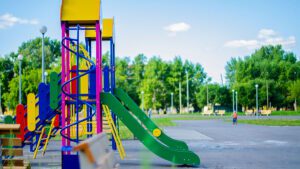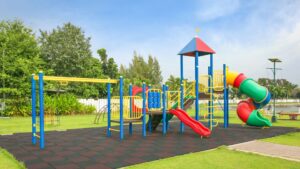Worn‑out slides, rusty swings, and missing bolts don’t just look bad—they pose safety risks. Whether you manage a schoolyard, public park, or backyard playset, knowing where and how to source playground replacement parts is crucial. In this 2,000‑word guide, you’ll learn how to:
- Assess equipment condition
- Identify manufacturer & model
- Contact suppliers & file warranty claims
- Use online forums and aftermarket options
- Handle DIY fixes—and when to call a pro
- Maintain equipment to minimize future replacements

1. Assessing Your Playground Equipment
Before ordering any parts, pinpoint exactly what needs replacing.
1.1 Visual Inspection
- Rust & Corrosion: Check metal posts, bolt heads, and brackets.
- Faded or Cracked Plastic: Inspect slides, tunnels, and panels for UV damage.
- Loose Fasteners & Friction Sounds: Listen for creaks that signal worn joints.
1.2 Prioritizing Safety
Replace anything that could injure a child immediately—loose chains, jagged edges, or splintered wood. For cosmetic issues like chipped paint, plan a later maintenance cycle.

2. Identifying Manufacturer and Model
Accurate identification speeds up part matching.
2.1 Locate the Data Plate
Find the metal tag or sticker—often under slides, inside tunnels, or on support beams. It lists:
- Manufacturer name
- Model number
- Serial number
2.2 Recover Lost Documentation
- Online Manuals: Many brands host PDF manuals via model lookup.
- Installer Records: Check purchase receipts or installation paperwork.
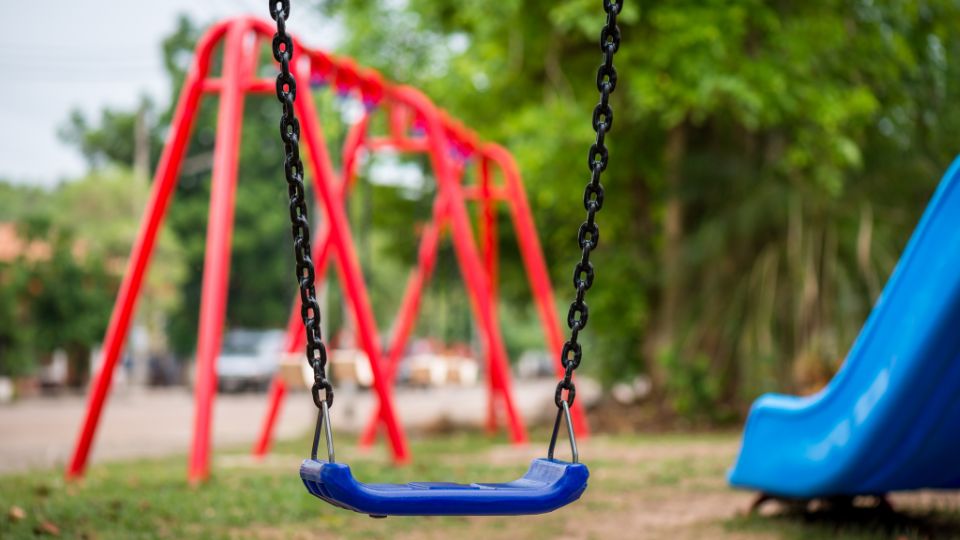
3. Contacting the Manufacturer or Authorized Supplier
Genuine parts ensure perfect fit and safety compliance.
3.1 Gathering Your Info
Have ready:
- Equipment model & serial numbers
- Photos of damaged components
- Purchase date & warranty documents
3.2 Reaching Out
- Email or Phone: Use the manufacturer’s service hotline.
- Authorized Distributors: They often stock common wear items like bearings, swing seats, and slide repairs.
- Warranty Claims: Confirm coverage and lead times—some parts ship free under warranty.
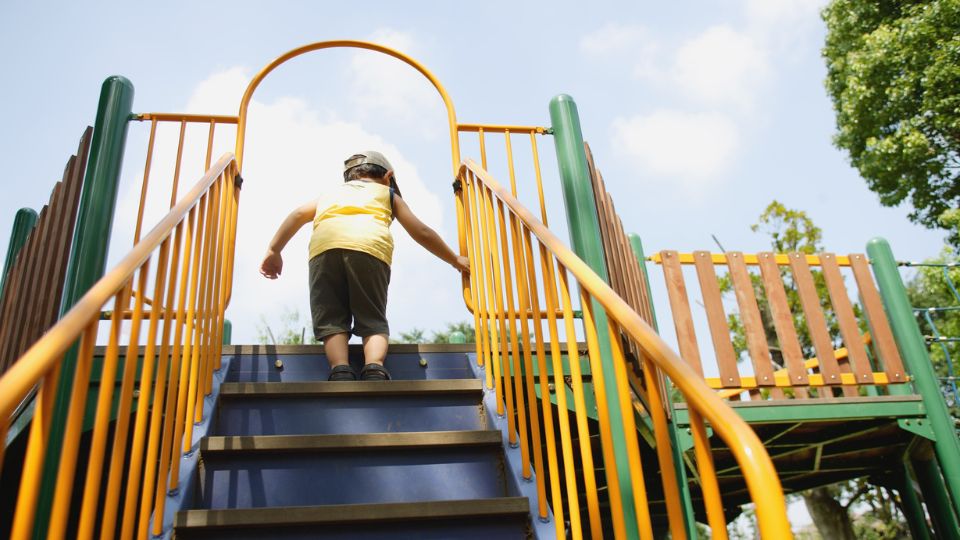
4. Filing a Warranty Claim
Many playground parts carry 1–5 year warranties—act fast!
- Review Terms: Check coverage period and excluded items (e.g., vandalism).
- Submit Documentation: Provide photos, serial numbers, and proof of purchase.
- Follow Up: Keep records of communication and expected delivery dates.
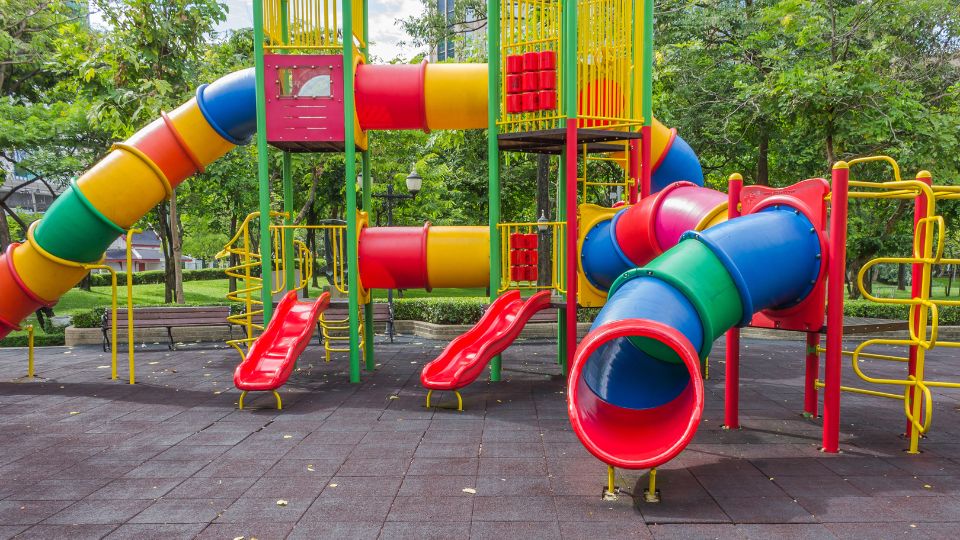
5. Leveraging Online Resources
When factory parts are unavailable or discontinued, the web is your friend.
5.1 Forums & Communities
- Playground Maintenance Groups: Facebook, Reddit, or specialty forums where professionals share tips and vetted suppliers.
- DIY Videos & Blogs: Step‑by‑step repair guides often link to third‑party retailers.
5.2 Aftermarket & Third‑Party Vendors
- Certified Replacements: Companies like WillyGoat or PlayPartsSupply offer OEM‑style components.
- Universal Hardware Kits: Bolt sets, brackets, and connectors compatible with multiple brands.

6. DIY Repairs and Creative Repurposing
For minor fixes or budget constraints, consider safe DIY solutions.
6.1 Common Materials
- Metal Brackets & Wood Planks: Reinforce weakened structures.
- PVC Pipes & Connectors: Build new handrails or repair play panels.
- Heavy‑Duty Ropes & Chains: Replace worn swing suspensions.
Warning: Only attempt DIY repairs for non‑structural parts. Always prioritize certified replacements for safety‑critical components.
7. Knowing When to Call a Professional
Complex or structural damage demands expert help.
7.1 Red Flags
- Major rusted or bent support posts
- Cracked main beams or load‑bearing welds
- Ground anchors or footings shifting
7.2 Finding Qualified Technicians
- Local Referrals: Schools, parks departments, or parent groups often recommend reliable contractors.
- Industry Directories: Search playground safety associations for certified installers.
8. Proper Installation & Routine Maintenance
Well‑installed and maintained equipment lasts years longer.
8.1 Installation Best Practices
- Follow manufacturer torque specs for bolts.
- Use galvanized or stainless hardware in outdoor settings.
- Ensure correct anchor depth and concrete footings for stability.
8.2 Maintenance Schedule
| Frequency | Tasks |
|---|---|
| Monthly | Tighten bolts, check chains, inspect wear areas |
| Quarterly | Lubricate moving parts, wash surfaces |
| Annually | Repaint metal, replace worn swing seats, audit safety surfacing |
Keeping a maintenance logbook helps track inspections and part replacements over time.
9. Preventing Future Part Shortages
Plan ahead to avoid equipment downtime.
- Stock Critical Spares: Keep extra swing seats, bolt kits, and slide liners on hand.
- Order Early for Discontinued Models: Manufacturers may phase out older parts.
- Upgrade to Modular Systems: Newer playsets use standardized components easier to replace.
Conclusion
Sourcing the right playground parts doesn’t have to be a scavenger hunt. By systematically assessing damage, identifying your equipment, leveraging manufacturer warranties, and tapping into online and aftermarket resources, you can keep your play area safe, attractive, and fun for years. Remember: timely maintenance and professional support for major repairs are investments in both safety and longevity—making every replacement part well worth it.

